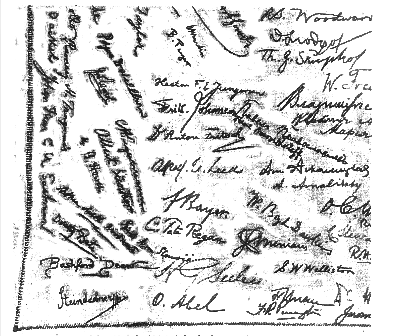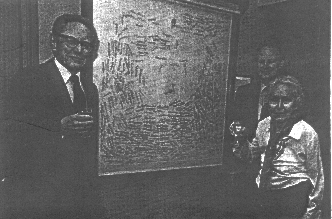
Lady Smith Woodward's tablecloth
B. B. G
[24] Sir Arthur Smith Woodward (1864-1944) joined the British Museum (Natural History) in 1882 (see The Linnean 2 (1):1, 11-14) and retired in 1924 after 42 years service. For thirty of those years he and his wife spent their vacations travelling extensively throughout Europe and America, visiting museums and universities in order to examine the various fossil collections contained therein. In so doing they built up an enormous circle of acquaintances, indeed, it may be said that A.S.W. knew personally almost all those connected with the subjects in which he was interested, and he had an inexhaustible fund of anecdotes concerning them.
Over the years many of these acquaintances, as well as other visitors from home and abroad, who came to visit the Department of Geology at the British Museum would be liberally entertained by the Woodward's, first at their house in South Kensington and after Arthur's retirement at their beautiful home in Haywards Heath (not far from Piltdown!).
Soon after their marriage (1894) Mrs. A.S.W. had the novel idea that instead of a visitors book all her distinguished visitors should sign her tablecloth (in pencil) and that she would later embroider the signatures in silk. This custom was kept up until Sir Arthur died in 1944 and Lady Woodward left Haywards Heath. Thus the tablecloth covers a 50-year period from the 1890s to the 1940s and contains some 350 signatures.
Every biologist would make his own list of notables, but here are a few: Othenio Abel, Robert Broom, Teilhard de Chardin, Raymond Dart, Louis Dollo, W. K. Gregory, E. S. Goodrich, Otto Jaekel, L.S.B. Leakey, O. C. Marsh, H. F. Osborn, C. Tate Regan, A. S. Romer, G. G. Simpson, Erik [25] Stensiö, Marie Stopes, D'Arcy Thompson, D.M.S. Watson.

A corner of the tablecloth which includes the signature of Arthur Smith Woodward.
In 1951 Lady Woodward made approaches to the then Keeper of Geology at the BM (NH), Dr. W. N. Edwards, concerning a permanent home for the tablecloth. Edwards told her that he did not think the British Museum (Natural History) had anywhere suitable to put it; whereupon Lady Woodward gave the tablecloth to George Gaylord Simpson, who took it back to the American Museum of Natural History, New York. Our picture quiz (The Linnean 3 (1):6) featured the tablecloth being formally received by the Director and staff at the AMNH, autumn 1951, where it was subsequently housed in the Department of Palaeontology (formerly Geology), BM(NH) -- the Department of which A.S.W. had for 22 years been Keeper.
[26] The cloth was subsequently cleaned and curated in the Victoria & Albert Museum (it was shown at the Linnean Conversazione, 1980) and has recently been framed and mounted courtesy of Mrs. Margaret Hodgson as a memorial to her father (A.S.W.).
It hangs outside the Keeper of Palaeontology's Office on the fourth floor of the BM(NH). A card index of identified signatures is kept nearby.

The unveiling of the tablecloth. L. to R., Dr. Bobb Schaeffer, Dr. Robin Cocks (Keeper), Mrs.
Margaret Hodgson.
On May 23rd 1987, in a small ceremony organized by Colin Patterson, Mrs. Hodgson officially unveiled the tablecloth. Guests included Dr. Bobb Schaeffer, Brian Gardiner and two of Lady Smith Woodward's grandchildren.
The Simroe Foundation 21 September 1984
Dear Professor Blinderman:
Having been quite ill for much of this year, I am just now trying to catch up with a great stack of letters and publications. I have now come to your letter of 30 August 1984.
As you have already completed your paper on Huxley vs Owen, I don't see any reason for my discussing them now. Obviously I never knew either of them although I am very familiar with their lives and works. (Also I was very closely familiar with the late Sir Julian Huxley for some
thirty years, and I am still in touch with Lady Huxley (Jullette), who survives Julian).
I can make some remarks about Sir Arthur Smith Woodward. I did not meet Sir Arthur until 1926, but I was fairly familiar with his previous work before that. He was almost infinitely best known for his extremely voluminous and detailed study of fossil fishes. He did also publish in 1898 what was for that time much the best book on fossil vertebrates in English for students.
I still found that useful when I began to study vertebrate paleontology many years later. (Smith Woodward was born 38 years before I was, and that textbook was published 10 years before I could even read English in first grade).
Besides fishes and a later translation of Zittel's German textbook of paleontology Smith Woodward did publish some of the earliest papers on British Mesozoic mammals. My doctoral dissertation at Yale had been on American Mesozoic mammals and in 1926-27 I had a grant to study European Mesozoic mammals, most of which were from England and a few of which in the British museum (Natural History) had been published on by Smith Woodward while he was on the B.M. (N.H.) staff. When he heard that I was restudying them he invited me to spend a long weekend at his home. This both delighted and awed me, because this man, so much older and wiser than I and then himself being the most famous of vertebrate paleontologists, wanted to become acquainted with me. To my astonishment, both this great man, Sir Arthur, and his wife, Lady Woodward, treated me as an equal, which I was then far from being and properly doubtful of ever becoming.
That was of course long before the discovery that "Piltdown Man" was a hoax. The fact that it was an out-and-out fake was not established until nine years after Sir Arthur died. This was the one great mistake in all of Smith Woodward's extremely voluminous work. He certainly never knew that his Eoanthropus dawsoni was a hoax. I am happy that he did not know this. I am also disgusted that he is now remembered mostly for this one big mistake and not for his thousands of correctly named and identified specimens in his hundreds of publications.
Perhaps two other points, not relevant to the Piltdown hoax, may be of some interest to you. While on the B.M. (N.H.) scientific staff Smith Woodward advanced steadily from a "second-class assistantship" at the age of eighteen to Keeper of the Department of Geology in 1892, when he was only twenty-eight. (At the B.M. (N.H.) a "keeper" is a curator or department head, and "geology" includes paleontology). He was retired by the museum in 1924, when he was sixty years old. He had, as he told friends, hoped to be made Director of the B.M. (N.H.). It has been said that he was so angry at not being made Director that he never entered the building or spoke to anyone still on the staff. He did keep in touch there but relatively little after he retired and moved out of London. He was rewarded by being knighted on retirement.
The other anecdote that may interest you is that Lady Woodward had scientific visitors to their home write their names in pencil on a large tea cloth and she then embroidered each signature in color. Each corner was devoted to some special interest of the Woodwards. (By the way, the surname has sometimes been hyphenated as Smith-Woodward, but not so by Sir Arthur or Lady Woodward). My name was added on my first visit to them. Some years later, after Sir Arthur had died and Lady Woodward was dividing her time between London and the country or a resort, she invited me to have lunch with her at a club while I was again in London. Of course I accepted. After lunch Lady Woodward brought out the resplendent tea cloth and presented it to me as a gift. I insisted that I was unworthy to have this as my property but she absolutely insisted that I accept and keep it because I was among the last of paleontologists on it. I did take it back with me to the United States, but on reading and rereading the splendid display I could not consider myself of such company. (I still do not.) I therefore formally presented it to the Department of Vertebrate Paleontology at the American Museum of Natural History. (There is a photograph of the presentation in my autobiography). When I left the A.M.N.H., in 1959, I asked about the cloth, but I found that no one still there remembered anything about it or could find it among the department memorabilia.
That still has a happy ending. When I was most recently back in the B.M.(N.H.) I told them about the Woodwards' tea cloth, its fit to me, my gift of it to the A.M.N.H., and its apparent loss from there. No one on the staff then had known about the now legendary tea cloth until it was suddenly found during a renovation of vertebrate paleontology there. It was then put on display there, and I saw the exhibit with my own name among dozens or even hundreds of others. No one now either at the B.M.(N.H.) or the A.M.N.H. had the slightest idea about the full history of this exhibit.
This is the longest letter I have written since I became ill months ago, and I am now quite worn out from writing it. I will have it typed and sent on to you. I hope it is of some interest to you.
However, I must still add a more curt reply to one of your questions. I hope your book about the Piltdown hoax does not blame this on either Sir Arthur Smith Woodward or Père Pierre Teilhard de Chardin. As regards the latter, Steve Gould's piece in Natural History for August, 1980 simply is not true or at best is not logical or acceptable. Teilhard, whom I knew very well, happened to be at the A.M.N.H. when the discovery that Piltdown man was a hoax was made known. Teilhard told me that he had never before known and that it had never occurred to him as possible that "Eoanthropus" was a hoax. Father Teilhard, S.J., was often mistaken, but to my knowledge he never lied outright. Who dunit? Most likely Dawson alone. For one more bit of evidence, he had perpetrated a previous hoax.
That really is the end of this letter.
Sincerely,
PIX SIGNATURE
George Gaylord Simpson